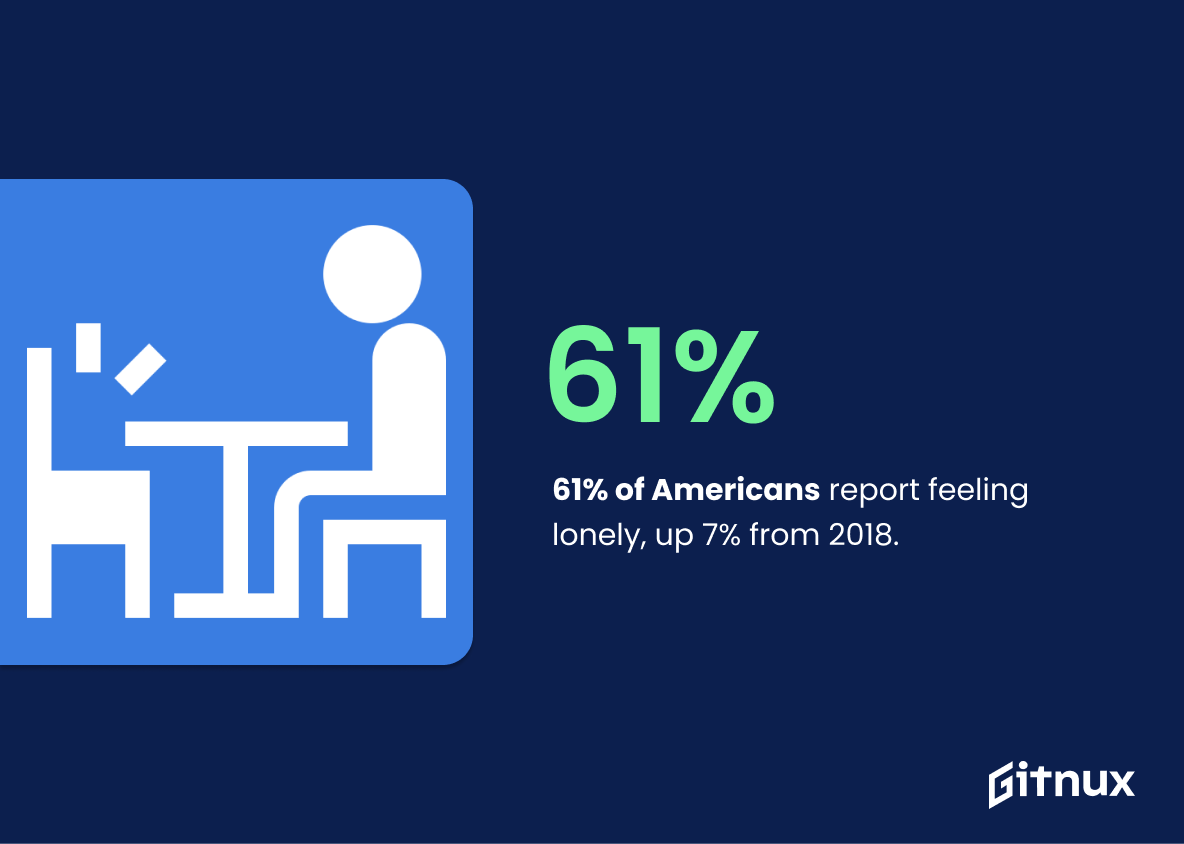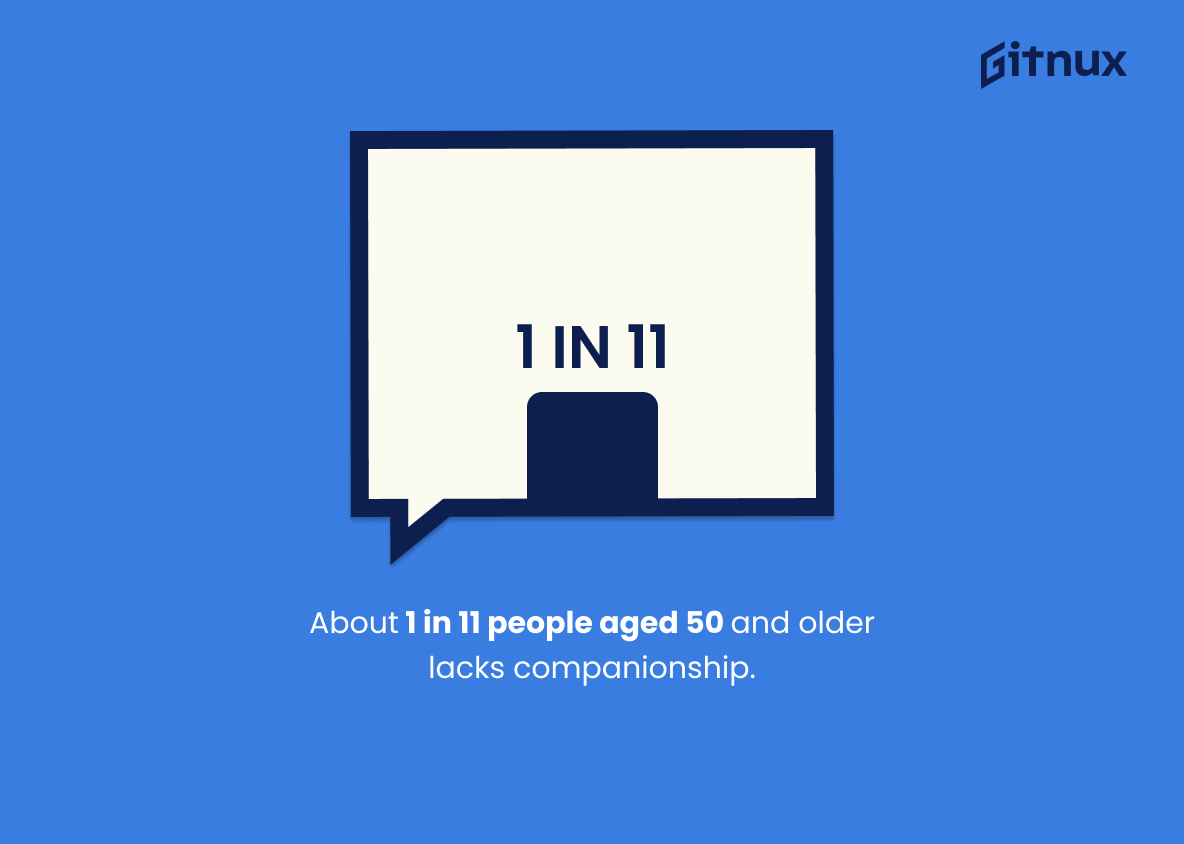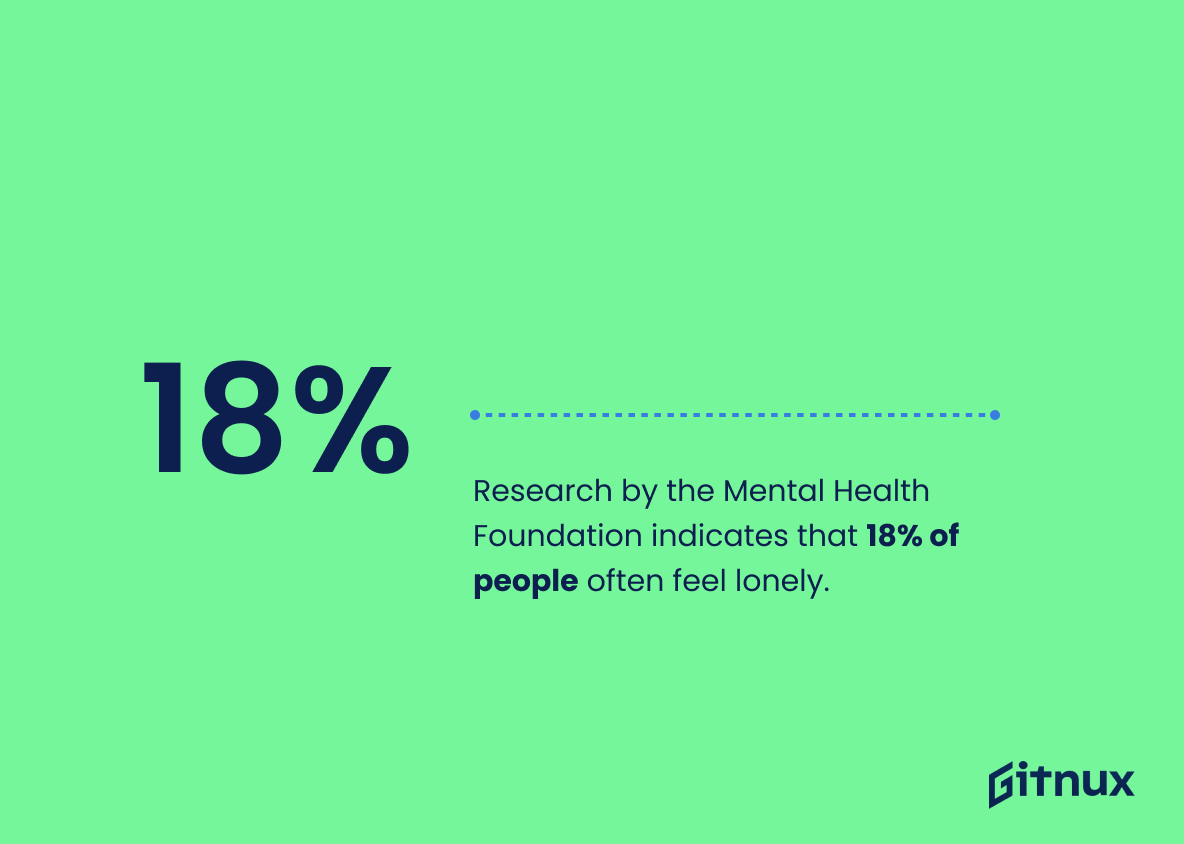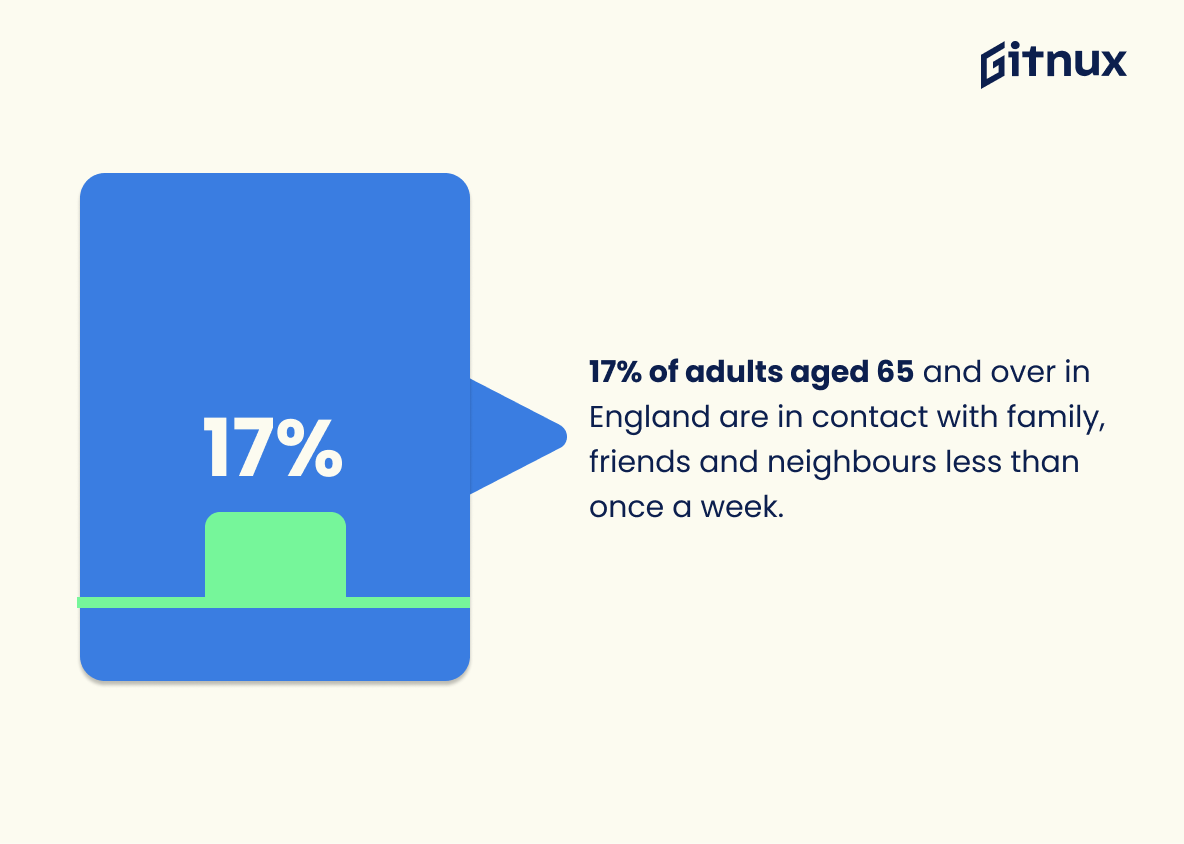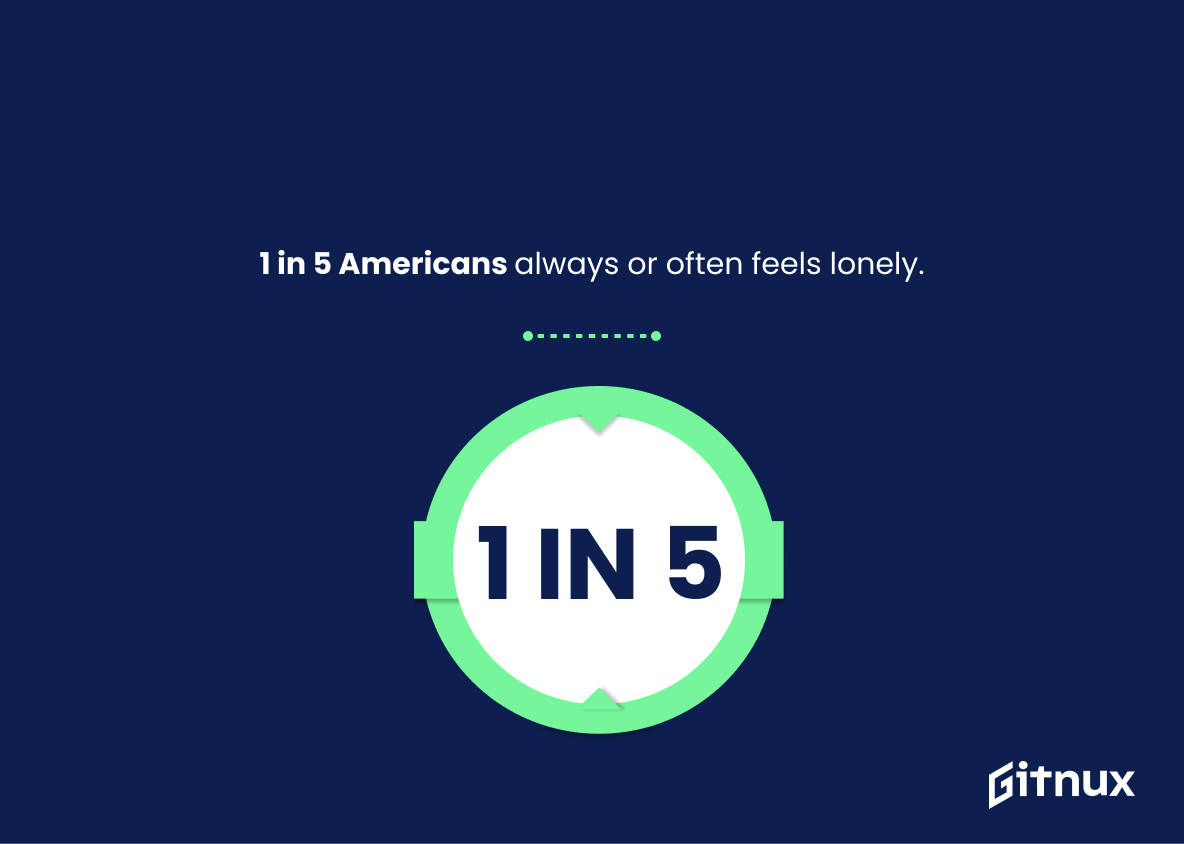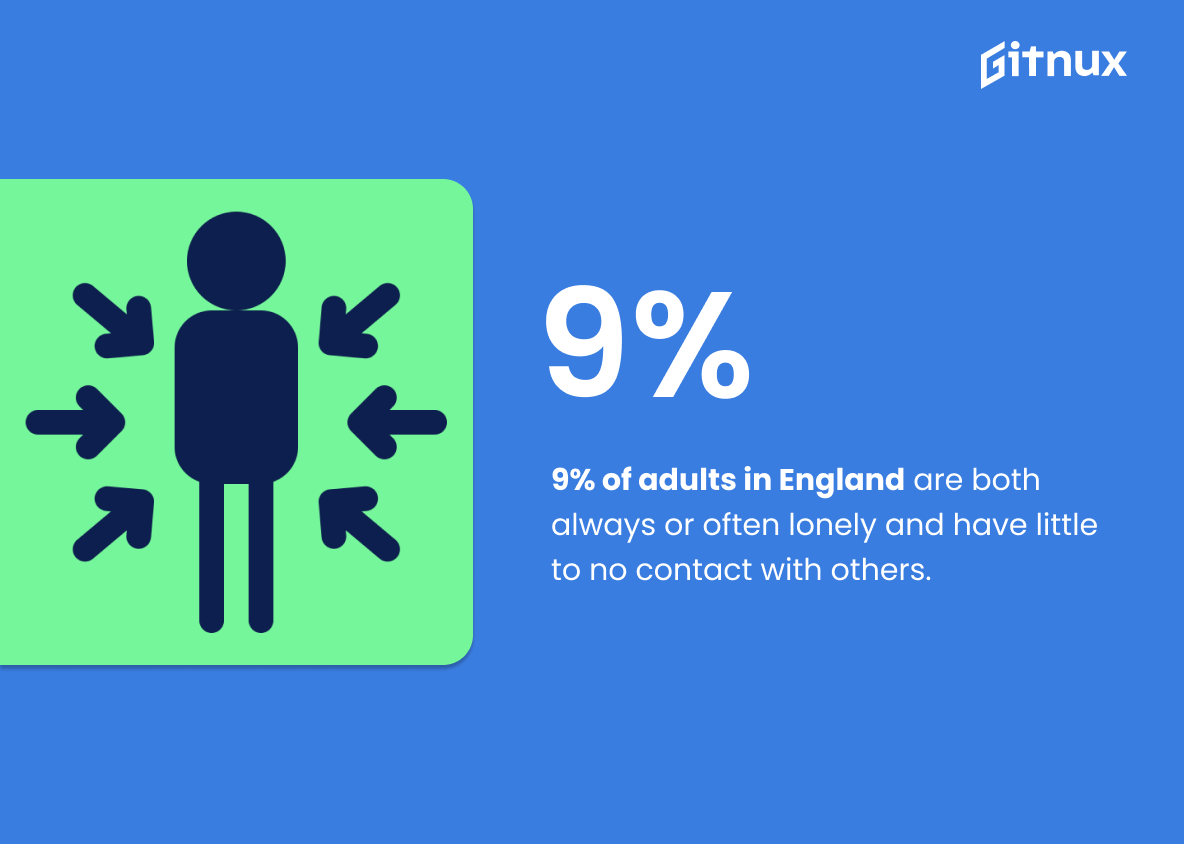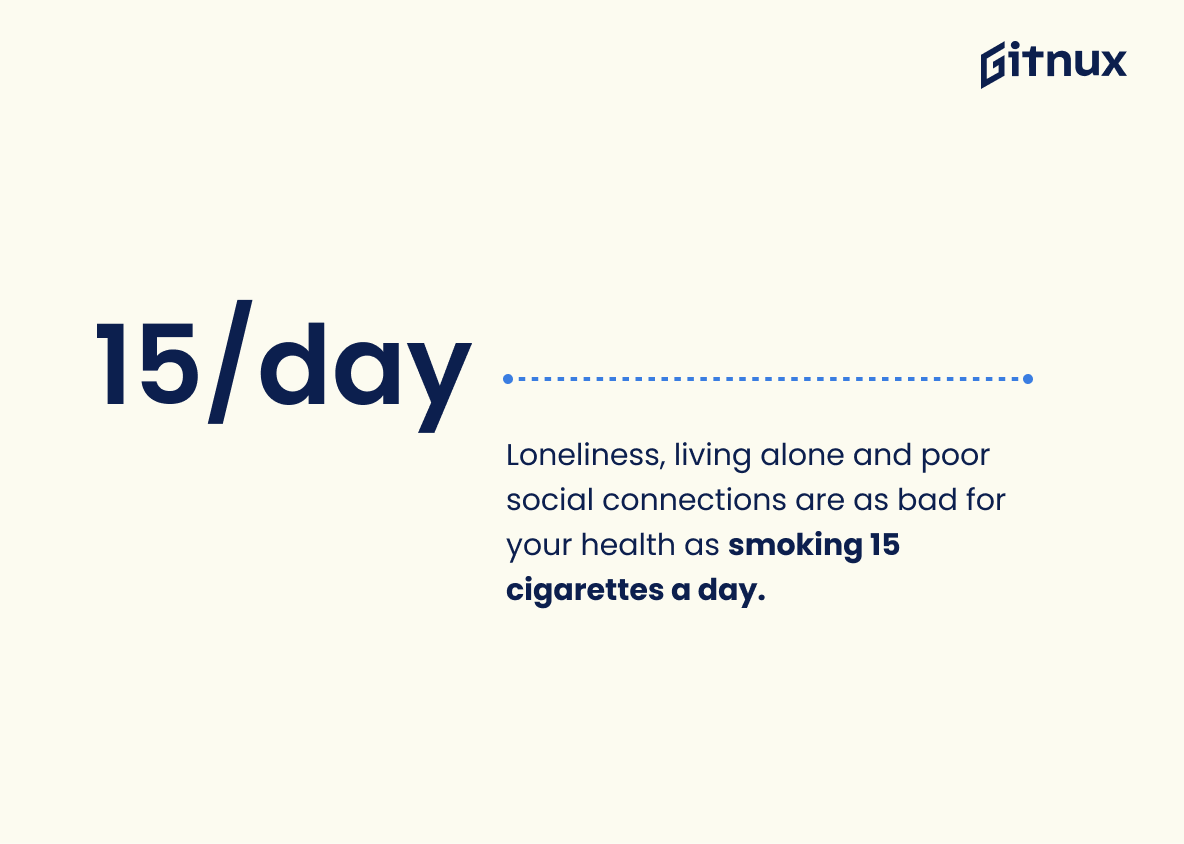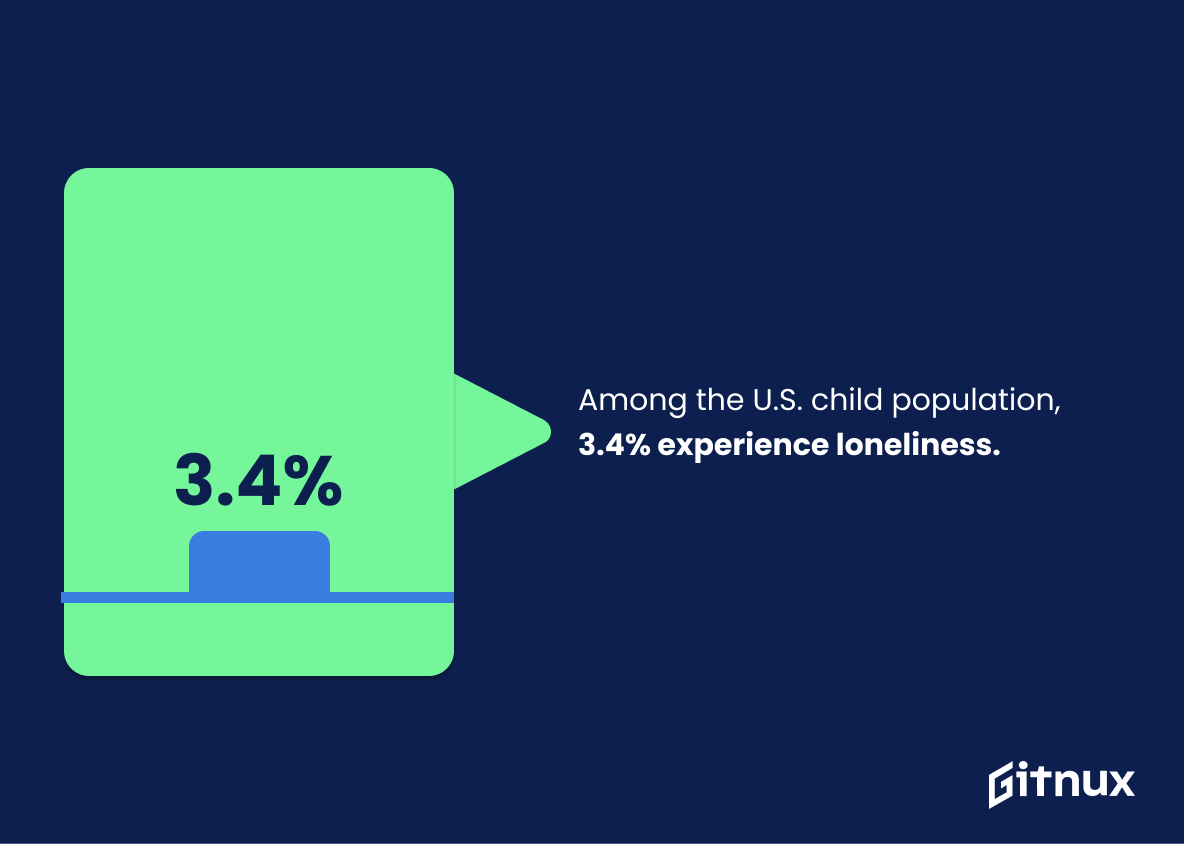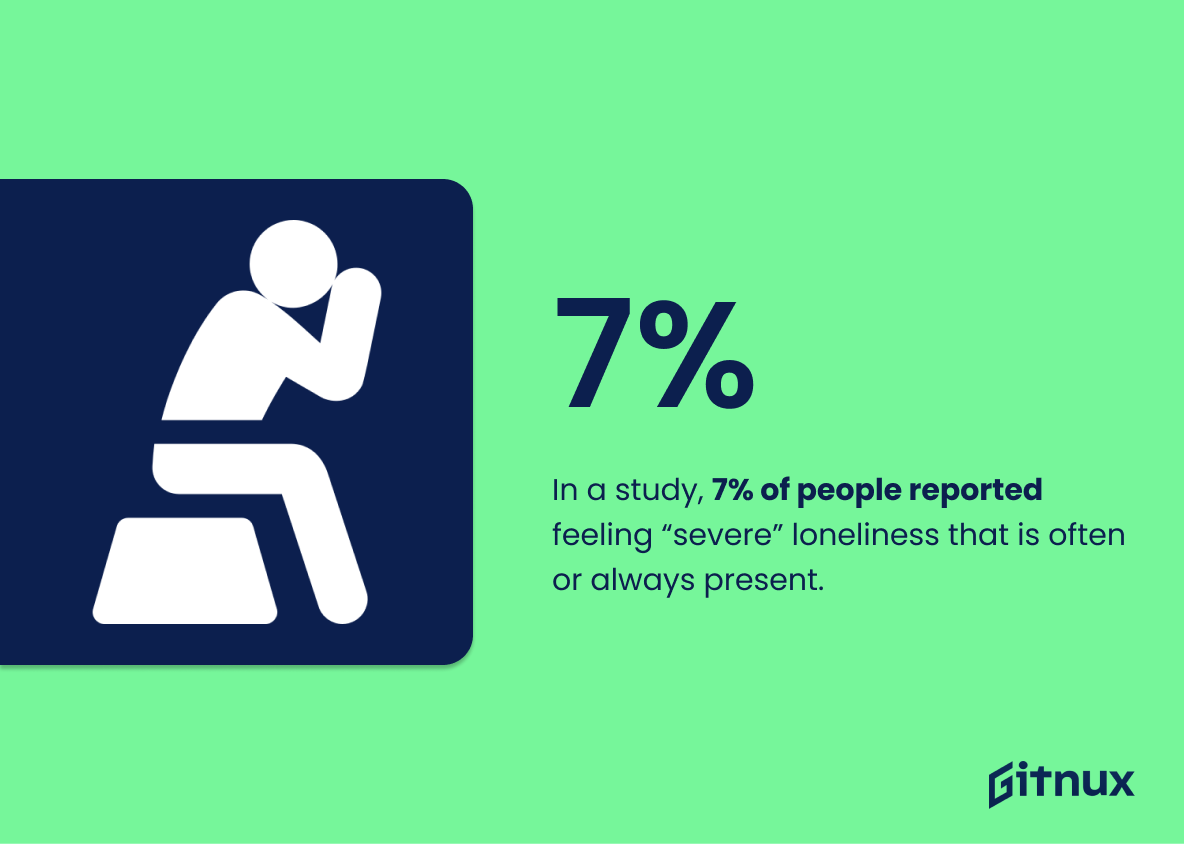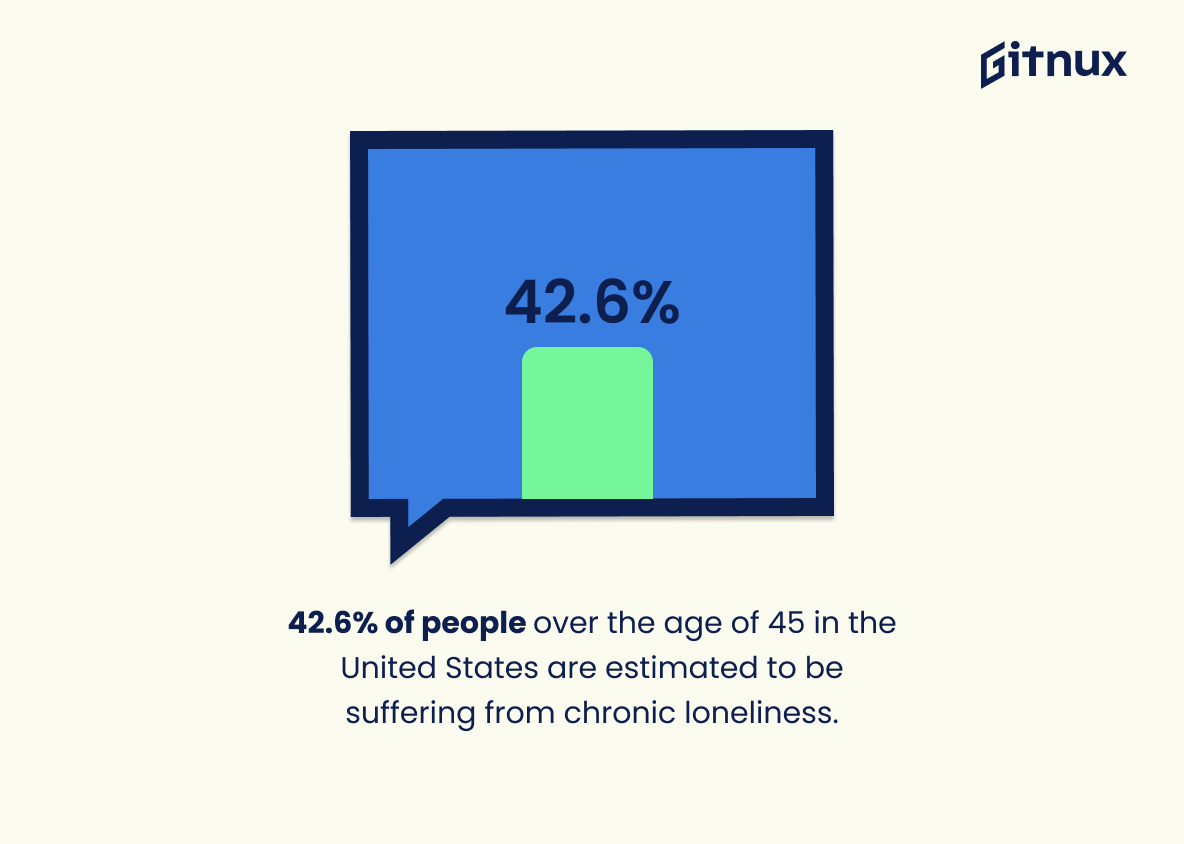In an increasingly connected world, it may seem paradoxical that loneliness, described as the subjective feeling of isolation, is experiencing a significant surge. Despite the convenience of digital interaction, real human connection appears to be dwindling, leading to a widespread epidemic of loneliness. This blog post shines a light on the various loneliness statistics that expose the depth and breadth of this silent issue.
It aims to provide a stark insight into how loneliness is much more than just a fleeting emotion, revealing its prevalence, risks, and impact on individuals across different demographics and societies. In acknowledging these statistics, we can better understand its implications, fostering discussions on how we can regain our innate human need for social connectedness.
The Latest Loneliness Statistics Unveiled
61% of Americans report feeling lonely, up 7% from 2018.
In our quest to understand the enigma of loneliness blanketing America, this startling revelation paints a poignant image: 61% of our neighbors are steeped in solitude, a somber leap from the past year’s 54%. That incremental 7% hike against the backdrop of 2018’s data isn’t merely a number.
It’s a crisp reflection of our society spiraling deeper into the void of loneliness. The numeric depiction of this upward trajectory is a visible signal—calling us to pay heed, explore, and address the surrounding issues—one percentage point at a time.
About 1 in 11 people aged 50 and older lacks companionship.
Highlighting the striking insight that approximately 1 in 11 individuals aged 50 and over find themselves without companionship shines a stark light on the prevalence of loneliness in later life. In a discussion centered around loneliness statistics, this fact drives home the silent epidemic sweeping through our aging population. It underscores an often overlooked reality, casting a spotlight on the silent sufferers and the escalating issue of loneliness among the elderly.
It serves as a poignant reminder that more needs to be done to address this complex emotional state affecting a significant portion of our senior communities. This statistic underscores the urgent call for innovative solutions and interventions to mitigate the loneliness in this demographic, thus fostering more meaningful connections among older adults.
Research by the Mental Health Foundation indicates that 18% of people often feel lonely.
Underscoring the blog post’s loneliness narrative, the compelling data provided by the Mental Health Foundation serves as a sobering revelation. An alarmingly high 18% of the population frequently experiences deep pangs of loneliness, highlighting the prevalence and seriousness of this emotional state.
This stark figure illuminates the loneliness epidemic, affirming the importance of addressing this often overlooked public health concern. It isn’t a minor issue affecting a niche group, but rather a universal concern with broad societal implications, needing more attention and actionable solutions.
17% of adults aged 65 and over in England are in contact with family, friends and neighbours less than once a week.
Diving into the depths of loneliness, we unravel an alarming revelation – a solitary figure floating amidst the sea of social interaction. Picture this, in the vibrant panorama of England, there exists a silent subsection: about 17% of adults aged 65 and over, their voices barely echoing in their less-than-once-a-week contact with family, friends or neighbours.
This figure serves as a stark reminder and a unique lens into the vastly unexplored chasms of loneliness engulfing our senior population, underscoring the urgency of addressing this issue with robust social and policy measures.
1 in 5 Americans always or often feels lonely.
In the realm of statistics illuminating the complexities of human emotions, the figure ‘1 in 5 Americans always or often feels lonely’ stands as a beacon. It lets us navigate the often murky waters of loneliness, its prevalence, and its profound impact. This figure sheds light on this pervasive issue, offering a stark reminder that loneliness is a silent epidemic sweeping across the nation, affecting a substantial proportion of its populace.
Within a blog about loneliness statistics, this insight becomes all the more critical. It serves as a rallying cry, doing more than merely quantifying the issue; it humanizes it, reminding readers that behind this significant statistic are real people grappling with feelings of isolation.
Furthermore, it provides a platform for further exploration, prompting a delve into the potential underlying causes, societal implications, and possible solutions for this widespread issue of loneliness. Ultimately, it’s an indispensable component, a compelling snapshot that brings the discussion around loneliness into sharp focus, offering a sobering perspective on a societal issue that demands attention.
9% of adults in England are both always or often lonely and have little to no contact with others.
Highlighting that 9% of adults in England frequently experience loneliness and minimal human interaction paints a stark picture of the breadth and depth of the loneliness epidemic. It underscores the silently growing crisis of isolation that penetrates the loud, busy fabric of modern life.
Interpreting this statistic further, it illuminates a compelling narrative that challenges us to rethink our understanding of societal bonds. This glows as a red alarm for advocates, policymakers, and mental health professionals, suggesting the urgent need to develop targeted interventions and resources. In terms of a blog post on Loneliness Statistics, this percentage serves as the cornerstone evidence in emphasising the scale and severity of solitude invading the lives of a formidable chunk of the population.
More than 2 in 3 caregivers report feeling isolated, and 57% say they have lost many or some friends as a result of caregiving.
The kaleidoscope of loneliness statistics is further painted with the poignant hues of caregivers’ experiences. A striking statistic reveals upward of two-thirds of caregivers narrate stories of feelings of isolation and loneliness. Almost 57% of them paint solemn portraits of lost friendships, the sacrifice made at the altar of caregiving.
This statistic reflects the emotionally complex journey of caregivers, underscoring the deafening silence of isolation that reverberates through their lives. In the grand mosaic of loneliness statistics, this figure stands as a solemn reminder of the price paid by these unsung heroes.
Loneliness, living alone and poor social connections are as bad for your health as smoking 15 cigarettes a day.
Peering through the lens of this statistic, we’re ushered into the alarming reality of how detrimental loneliness, solitary living, and lack of social connections can be for an individual’s health. Setting it side by side with the health impact of smoking 15 cigarettes a day casts a stark light on the seriousness of the issue.
It punctuates a vital point in a blog post about loneliness statistics, helping to underscore the gravity of loneliness as a public health concern. It’s a call to arms, beckoning readers to understand the urgency in finding solutions to alleviate loneliness, just as we fervently seek ways to reduce smoking.
Among the U.S. child population, 3.4% experience loneliness.
Highlighting that 3.4% of the U.S. child population experiences loneliness sheds a spotlight on an often overlooked demographic. Painted against the backdrop of youthful cheer and innocence, this figure serves as a heartrending underscore of an issue that is commonly associated with older age groups. This jarring contrast evokes both empathy and urgency among readers, prompting a holistic understanding of loneliness, its prevalence and unseen victims.
Incorporating this statistic in a blog post about loneliness broadens the conversation, emphasizing that it transcends age, affecting even the seemingly carefree lives of children. An audience might be more motivated to explore and mitigate this issue, knowing that it cloaks itself in the shadows of the very young who have yet to navigate the full spectrum of life’s joys and challenges.
28% of older adults live alone, many of whom may experience loneliness.
In the vast universe of loneliness statistics, one figure leaps powerfully off the page — 28% of older adults live in solitude, a condition that often paves the way to loneliness. This striking percentage illuminates multiple dimensions of the phenomenon under discussion.
Firstly, it underscores how loneliness is not merely an abstract concept but a stark reality for a sizable proportion of our elderly population. Secondly, it shapes us a poignant picture of how our society, while technologically connected, can still leave a significant number of its members feeling isolated, serving as a potent reminder of the need for more inclusive community engagement strategies.
Lastly, it serves as fodder for policy intervention, spotlighting an area that needs more attention. So, spare a thought for this 28%; their silent whispers of solitude are calls for action and understanding. They’re not just figures on a statistics chart, but human beings deserving of companionship and care in their sunset years.
In a study, 7% of people reported feeling “severe” loneliness that is often or always present.
Highlighting the intriguing fact that 7% of individuals grapple with the persistent presence of “severe” loneliness offers a striking perspective into this widespread issue. It not only underscores the magnitude of the problem, but it also demonstrates the intense, personal experience of those living in constant isolation.
Embellishing the reality of loneliness, this statistic aids in underlining the urgent need for robust interventions and fosters a deeper understanding of the issue among readers. Therefore, it forms a compelling cornerstone to any discussion around Loneliness Statistics. Being more than just a number, it invites us to question its roots and effects, sparking a meaningful dialogue about how we, as a society, can navigate loneliness.
42.6% of people over the age of 45 in the United States are estimated to be suffering from chronic loneliness.
Highlighting such a significant number as 42.6% of individuals over the age of 45 experiencing chronic loneliness sheds light on the fact that loneliness isn’t just an isolated problem, but rather a widespread phenomenon affecting nearly half the mature population in the U.S. It validates the gravity of the loneliness epidemic, underscoring its noteworthy prevalence among older adults, thereby reinforcing the urgency to address this public health concern effectively.
This figure becomes the heartbeat of the blog post on Loneliness Statistics and a call to awareness and action for the readers, provoking thought and empowering them to confront and challenge this silent scourge in our society.
Conclusion
In conclusion, the loneliness statistics highlighted in this post reveal an unsettling phenomenon unfolding in our society. It is evident that loneliness is no longer just an emotional condition but a societal concern that has significant ramifications for individuals’ overall health and wellbeing. It is critical that we address these growing rates, not just for the benefit of the lonely individuals, but for the health of our society as a whole.
Whether by extending care towards those who are isolated, enhancing programs aimed at social connection, or simply promoting open conversations about loneliness, there are tangible steps that can be taken to help combat this epidemic. Together, we can transform these statistics and foster a more socially connected world.
References
0. – https://www.www.healthline.com
1. – https://www.www.ncbi.nlm.nih.gov
2. – https://www.www.cigna.com
3. – https://www.acl.gov
4. – https://www.connect2affect.org
5. – https://www.www.cambridge.org
6. – https://www.www.ageuk.org.uk
7. – https://www.www.aarp.org
8. – https://www.www.mentalhealth.org.uk
9. – https://www.www.gov.uk
10. – https://www.www.campaigntoendloneliness.org
